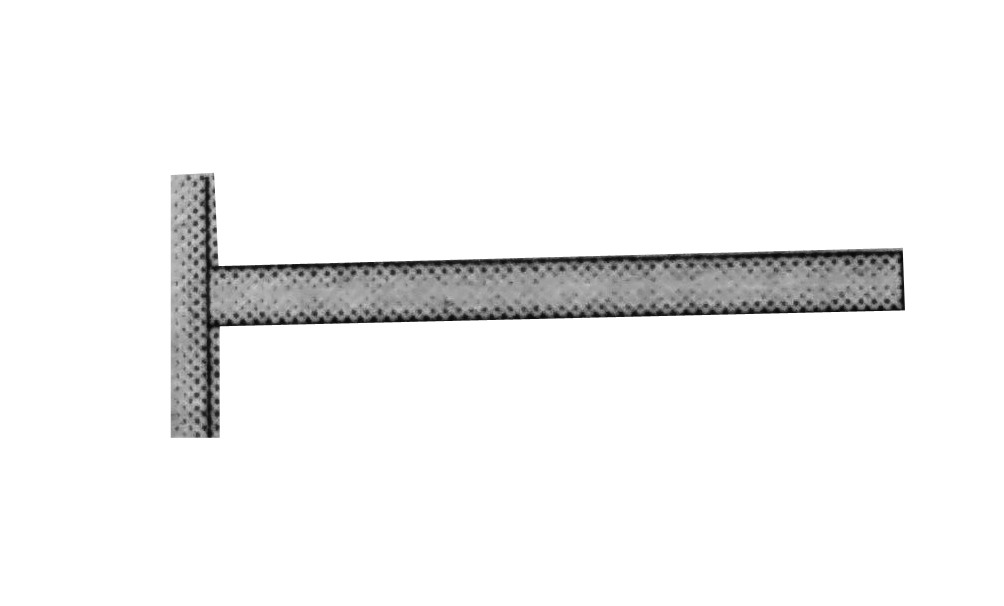A brass rod of length 1m is fixed to a vertical wall at one end, with the other end keeping free to expand. When the temperature of the rod is increased by 120∘C, the length increases by 3cm. What is the strain?
After the rod expands to the new length, there are no elastic forces developed internally in it.
So strain =0
Topper's Solved these Questions
- PROPERTIES OF SOLIDS AND FLUIDSBook:CENGAGE PHYSICSChapter:PROPERTIES OF SOLIDS AND FLUIDSExercise:Solved Examples
Explore 11 Videos
- PROPERTIES OF SOLIDS AND FLUIDSBook:CENGAGE PHYSICSChapter:PROPERTIES OF SOLIDS AND FLUIDSExercise:Exercise 5.1
Explore 12 Videos
- NEWTON'S LAWS OF MOTION 2Book:CENGAGE PHYSICSChapter:NEWTON'S LAWS OF MOTION 2Exercise:Integer type
Explore 1 Video
- RIGID BODY DYNAMICS 1Book:CENGAGE PHYSICSChapter:RIGID BODY DYNAMICS 1Exercise:Integer
Explore 11 Videos
Similar Questions
Two rods of equal cross sections, one of copper and the other of steel, are joined to form a composite rod of length 2.0 m at 20∘C, the length of the copper rod is 0.5 m. When the temperature is raised to 120∘C, the length of composite rod increases to 2.002m. If the composite rod is fixed between two rigid walls and thus not allowed to expand, it is found that the lengths of the component rods also do not change with increase in temperature. Calculate Young's modulus of steel. (The coefficient of linear expansion of copper, αc=1.6×10−5∘C and Young's modulus of copper is 1.3×1013N/m2).
View SolutionA rod of length l is released from the vertical position on a smooth horizontal plane. What is the nature of motion of the free end of the rod ?
View Solution
Knowledge Check
The value of a is numerically equal to the percentage change in length when the temperature of the rod is increased by
A1∘CB1KC273 CD100∘CTwo rods of different materials and identical cross sectional area, are joined face to face at one end their free ends are fixed to the rigid walls. If the temperature of the surroundings is increased by 30∘C, the magnitude of the displacement of the joint of the rod is (length of rods l1=l2=1unit, ratio of their young's moduli, Y1/Y2=2, coefficients of linear expansion are α1 and α2)
A5(α2−α1)B10(α1−α2)C10(α2−2α1)D5(2α1−α2)
In the given figure, a rod is free at one end and other end is fixed. When we change the temperature of rod by Δθ, then strain produced in the rod will beAαΔθB12αΔθCzeroDinformation incomplete
A rod of length / and radius r is held between two rigid walls so that it is not allowed to expand. If its temperature is increased, then the force developed in it is proportional to
View SolutionIf rod is initially compressed by Δl length then what is the strain on the rod when the temperature
(a) is increased by Δθ (b) is decreased by Δθ
View SolutionA brass rod of length 50 cm and diameter 3.0 mm is joined to a steel rod of the same length and diameter. What is the change in length of the combined rod at 250∘C, if the original lengths are at 40.0∘C? Is there a 'thermal stress' developed at the junction ? The ends of the rod are free to expand. Coefficient of linear expansion of brass =2.0×10−5.∘C−1 and that of steel =1.2×10−5.∘C−1.
View SolutionTwo rods of equal cross-sections, one of copper and the other of steel are joined to from a composite rod of length 2.0m at 20∘C the length of the copper rod is 0.5m. When the tempertuare is raised to 120∘C, the length of composite rod increases to 2.002m. If the composite rod is fixed between two rigid walls and thus not allowed to expand, it is foundthat the length fo the component rod also do not change with increase in temperature. Calcualte the Young's modulus of steel. Given Young's modulus of copper =1.3×1011N/m2 the coefficent of linear expansion of copper αC=1.6×10−5/.∘c
View SolutionA thin rod of negligible mass and area of cross section S is suspended vertically from one end. Length of the rod is L0 at T∘C . A mass m is attached to the lower end of the rod so that when temperature of the rod is reduced to 0∘C its length remains L0 Y is the Young’s modulus of the rod and α is coefficient of linear expansion of rod. Value of m is :
View Solution

